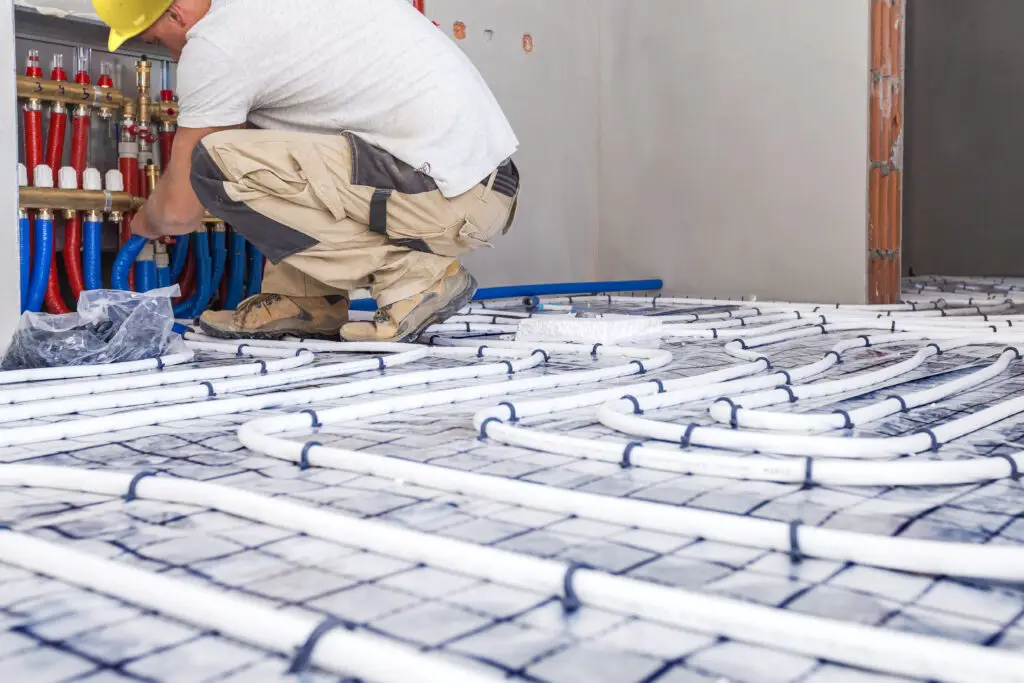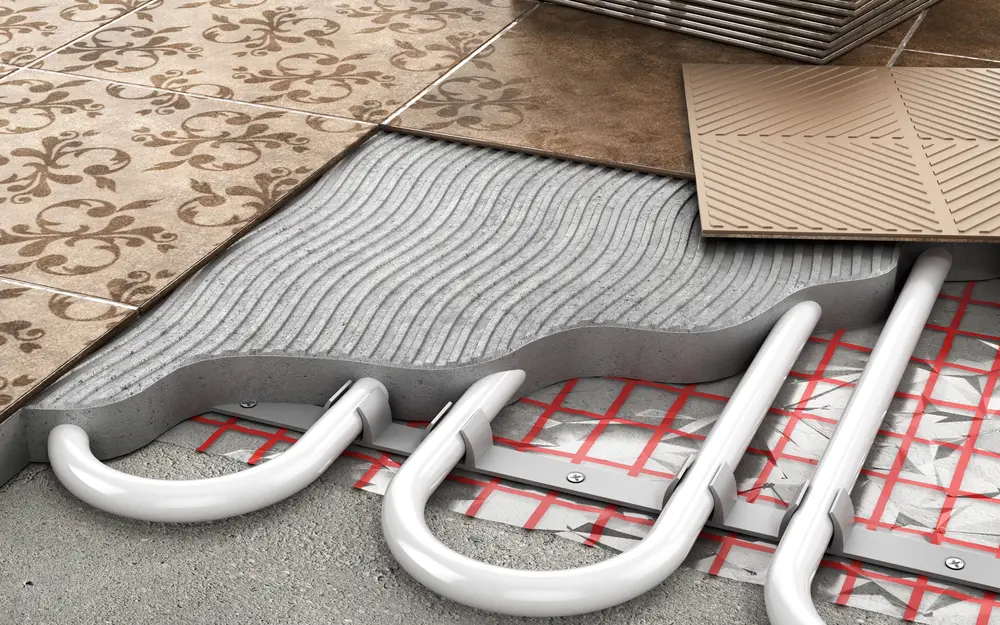Underfloor heating provides an energy-efficient and versatile method of home heating. If you are considering adding underfloor heating to your home you should know about the associated risks and benefits.
Underfloor heating systems are one of the safest domestic heating solutions available, with a very low risk of fire compared with other heating methods when professionally installed. There is a risk of fire if heated floors are covered by unsuitable materials or installed incorrectly.

Are heated floors a fire hazard?
Electric underfloor heating systems have gained popularity in recent years because of their easy installation and very safe operation. The electric underfloor heating system comes in the form of a very thin wire mesh that is installed underneath the floor, this is then powered by the main electric supply of the house. The wire mesh heats up and this heat is conducted throughout the floor to the room, resulting in an evenly heated room, with no hot or cold spots.
Unless an electric underfloor heating system is improperly installed, or safety instructions are not followed at installation, they are a very safe method of heating your home.
The water-based or hydronic water heating system is a little unconventional for already constructed houses as it is costly to install later, but for newer constructions, it is the ideal choice as it has lower running costs as compared to an electric underfloor heating system.
Hydronic underfloor heating also works by the principle of thermodynamic heat transfer, but here, hot water is pumped through pex pipes installed under the floor throughout the house, these pipes are properly insulated to transfer the most heat to the top of the floor, and this is why it gives a warm, cozy feeling when working, and no noise or dry feeling that is common with radiator.
Hydronic underfloor heating systems do not require boiling water to be pumped through the pipes, as is the case with radiators; this means that they are even less of a fire risk than conventional radiator heaters.

Electric Underfloor Heating Fire Risk?
Electric underfloor heating systems are very safe to run, but the most critical part of the underfloor heating systems is the installation. The underfloor heating systems should be installed with the help of a registered professional. And even then, care should be taken that the wire in the mesh should not be cut short, during installation.
If electric underfloor heating system is being installed in an old house, it should be ensured that the pre-existing circuitry of the house can take the load, and if not, new fuses and wiring should be installed. Otherwise, this is the greatest fire risk in the installation.

Water Underfloor Heating Fire Risk?
Water Underfloor heating systems use a water heater that mostly uses gas to heat up the water, this poses as much a fire risk as a conventional radiator, perhaps less as the water is heated to a lower temperature. Theoretically, the pipes that pump can leak, but as all the pex-pipe has no joints, so there is no critical pressure point and this is quite unlikely.
Even if there is a leak, there is no chance of a burn, as water underfloor heating systems operate at a temperature around 50 degrees, as compared to a radiator, which reaches twice that.
You should ensure that the gas (or electrical) supply that heats the water in a hydronic underfloor heating system is installed and maintained appropriately.
What factors increase the risk of fire with underfloor heating?
Non-professional installation of an underfloor heating system is the biggest factor in the failure of a system. Only a professional should install the system, and after installation, it should be made sure that the entire screed has dried up or it could heat up and crack the floor.
The underfloor heating system should not be turned on until and all adhesives have dried and all wiring is completed it can take up to 14 days for this to be completed, but it is better to be safe. When running an underfloor system, it should be made sure that the thermostat installed supports the underfloor heating systems.

There should be special care taken in insulating the underfloor, and it is of the utmost importance that there are no air pockets in the insulation, as this leads to that part of the system heat up more in the absence of insulation and cause a break.
Also if temperature sensors are positioned around places that can be influenced by heat, like fireplaces and kitchens, it can lead to wrong readings being taken and the system tripping prematurely, when you would increase the temperature to counter that, it can cause the system to overheat.
Another cause of overheating and possible burning of underfloor systems is the ignorance of standard operating procedures (classic do’s and don’ts). The user guide clearly mentions that this is a conduction-based heating system and it requires continuous air circulation above the floor. Still, some consumers cover the underfloor heating system with large furniture and in some cases, even mattresses.
There are some specific types of rug that can be used with underfloor heating, but unless you check the thickness, material and general compatibility recommendations we would advise against this. You can learn more about this in our dedicated article here.

This restriction in the access to air causes the underfloor heating systems to overheat. There should be nothing covering the underfloor heating systems, even low-lying furniture should be avoided. If doing so is unavoidable, it should be raised a little to allow some air to flow (eg the sofas raised with feet).
Is underfloor heating dangerous?
Underfloor heating is a very safe form of heating homes, if it had posed any threat to the safety of the building or its residents, it wouldn’t be a global market size of $4.6 billion in 2020, predicted to cross the $6.6 billion mark by 2025.5
Underfloor heating systems have seen stout support from government because of their safety and energy efficiency. The real reason is, that this is in contrast a new technology, and people hesitate to shift to a fresh experiment without the accompanying long term evidence. Furnaces and radiators are being used by consumers in their homes for decades.
This report by the National Fire Protection Agency examined home heating fires between 2014 and 2018 and found that the majority of fires and accidents were in the context of fixed and portable storage heaters, followed by open fires with chimneys. Central heating and water heating systems were further down the list and underfloor heating did not feature on the list.
The same report states that heating equipment is a leading cause of fires in U.S. homes. Local fire departments responded to an estimated average of 48,530 fires involving heating equipment each year in 2014-2018. These fires resulted in annual losses of 500 civilian deaths, 1,350 civilian injuries, and $1.1 billion in direct property damage. 4
Underfloor heating systems have such a clean record of operation that there are no large sample statistics compiled regarding any fires caused by underfloor heating systems malfunctioning. We could not find any reports of significant numbers of accidents, fires or other issues attributed to underfloor heating. Underfloor heating should be considered a safe alternative to the preexisting heating devices.
Lots more Underfloor Heating Information Here
- What Depth is Required for Underfloor Heating?
- Turning on Underfloor Heating for the First Time – How Long to Wait?
- Can you lay Vinyl flooring over underfloor heating?
- Do Tiles Crack With Underfloor Heating?
- Can You Heat a Whole House With Underfloor Heating?
- Can You Have Underfloor Heating Upstairs?
- Will Underfloor Heating Raise My Floor? – Underfloor Heating Layers Explained
- Can I put furniture on top of underfloor heating?
- How Do I Know If My Underfloor Heating is Leaking?
- Can You Combine Underfloor Heating With a Ground Source Heat Pump?
- Is Underfloor Heating Safe?
- Does Underfloor Heating Add Value to a Property?
- Can you have Wooden Floors with Underfloor Heating?
- Can Underfloor Heating Cause a Fire?
- What temperature should Underfloor Heating be set at?
- Can I Put a Rug Over Underfloor Heating?
- How Long Does it Take for Underfloor Heating to Warm Up?
- Why is my Underfloor Heating Noisy?
- Why is my Underfloor Heating Patchy?
- How do I know if My Underfloor Heating is Working? – Common Problems & Fixes
- What can go wrong with underfloor heating?
- Can you Combine Underfloor Heating with an Air Source Heat Pump?
- Do you keep underfloor heating on all the time?
- Does Underfloor Heating work with Smart Thermostats?
- Kitchen Underfloor Heating – Should Underfloor Heating go Under Kitchen Units?
- How much energy does Underfloor Heating use?
- Underfloor Heating in Summer and Winter
- Lifespan of Underfloor Heating
